Unique Ornamental Trees
There are more than a few unique trees that make a real statement in the landscape. We’ve selected a handful of decorative tree options that are especially appealing for specimen trees. They range from a soaring deciduous redwood to a white-flowering small tree perfect for smaller gardens.
1. Dawn Redwood
Botanical name: Metasequoia glyptostroboidesUSDA zones: 4-8Height: to 80 feet (28 m)
This redwood “came back from the dead” in an amazing part of botanical history. Dawn redwood was considered extinct for decades, and the tree was only known through fossil records. But in 1945, a botanist discovered some of this species in a remote area in China. Seeds were gathered and distributed, and now these fast-growing, deciduous redwoods are found in botanical gardens around the globe. This pyramidal tree has feathery needles as foliage. It leafs out early and holds onto its foliage well into fall.
2. Paperbark Maple
Botanical name: Acer griseumUSDA zones: 4-7Height: to 25 feet (8.3 m)
I love maples, with their peeling bark and pretty fall color. But the paperbark maple is exceptional in both categories. This small tree has open branching that allows you to admire the trunk as its bark exfoliates in paperlike strips. Beneath is penny-colored bark that lights up the landscape in winter.
3. Amur maackia
Botanical name: Maackia amurensisUSDA zones: 3-7Height: to 30 feet (10 m)
Small but showy, this garden-size deciduous tree has dark green leaves, but it really shines when covered with an abundance of white blossoms in summer. This makes amur maakia a special ornamental tree since few other trees are flowering at that time. Tolerant and easy-care, it has few pest or disease issues.
4. Japanese snowball
Botanical name: Styrax japonicusUSDA zones: 5-7Height: to 20 feet (6.6 m)
In stark contrast to the redwood described above, the Japanese snowball stays small and often spreads farther than its height. The forest green leaves appear first on curving, horizontal branches, and they are followed by dangling white flowers, graceful and plentiful. Mother Nature designed this tree nicely, since the fully developed leaves grow on the upper side of each branch, while the dropping flowers hang below. This ultimate specimen tree grows in full sun or light shade.
5. Weeping mulberry
Botanical name: Morus alba “pendula"USDA zones: 4-8Height: to 30 feet (10 m)
This is not your grandmother’s white mulberry plant! Mulberries are a dime a dozen but the weeping mulberry isn’t very common. Fast-growing and fruitless, these landscape plants have canopies lush with dark green leaves that cascade down in weeping growth. The trees are vigorous and resilient.
6. Cedar of Lebanon
Botanical name: Cedrus libani var. stenocomaUSDA zones: 5-7Height: to 50 feet (16.6 m)
True cedars warm the cockles of any tree-lover’s heart – and are impressive in a garden setting. The Cedar of Lebanon takes the prize as the most cold-hardy of the true cedars, and the attractive pyramidal form it has during its youth evolves in wide, spreading branches as it matures. Slow-growing and majestic, these cedars are truly decorative trees.
7. Cryptomeria
Botanical name: Cryptomeria japonicaUSDA zones: 6-8Height: to 60 feet (20 m)
Also called Japanese cedar. If you are interested in inviting this unusual tree into your landscape, you’ll need to be willing to protect it. If winter is severe in your region, this appealing evergreen with short, bright green needles on drooping branches can suffer from winter damage. The young tree is conical, but its branches spread wide as it matures. Where to plant a cryptomeria? In a protected site that gets full sun, out of the path of winter winds.
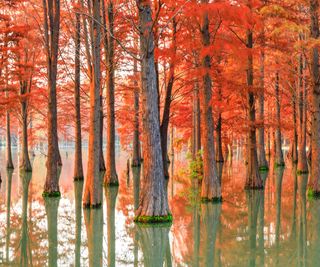
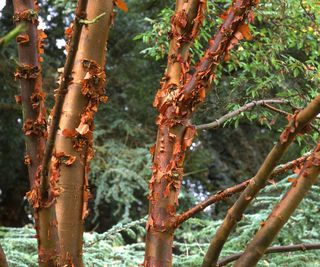
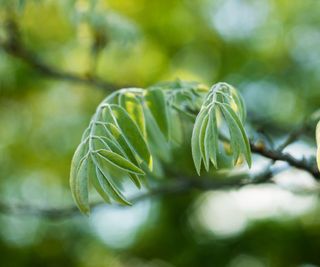
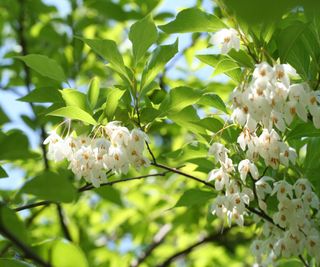
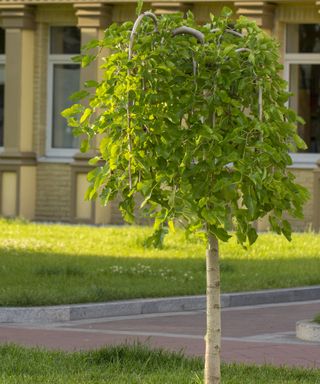
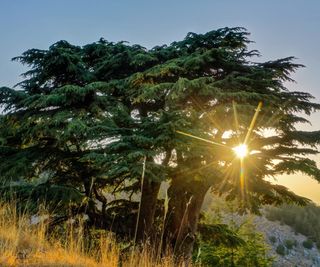
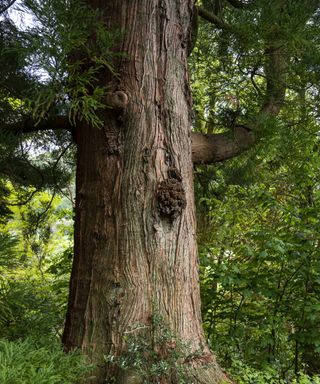
title: “7 Unique Ornamental Trees To Spruce Up Your Landscape” ShowToc: true date: “2024-09-29” author: “Frederick Corso”
Unique Ornamental Trees
There are more than a few unique trees that make a real statement in the landscape. We’ve selected a handful of decorative tree options that are especially appealing for specimen trees. They range from a soaring deciduous redwood to a white-flowering small tree perfect for smaller gardens.
1. Dawn Redwood
Botanical name: Metasequoia glyptostroboidesUSDA zones: 4-8Height: to 80 feet (28 m)
This redwood “came back from the dead” in an amazing part of botanical history. Dawn redwood was considered extinct for decades, and the tree was only known through fossil records. But in 1945, a botanist discovered some of this species in a remote area in China. Seeds were gathered and distributed, and now these fast-growing, deciduous redwoods are found in botanical gardens around the globe. This pyramidal tree has feathery needles as foliage. It leafs out early and holds onto its foliage well into fall.
2. Paperbark Maple
Botanical name: Acer griseumUSDA zones: 4-7Height: to 25 feet (8.3 m)
I love maples, with their peeling bark and pretty fall color. But the paperbark maple is exceptional in both categories. This small tree has open branching that allows you to admire the trunk as its bark exfoliates in paperlike strips. Beneath is penny-colored bark that lights up the landscape in winter.
3. Amur maackia
Botanical name: Maackia amurensisUSDA zones: 3-7Height: to 30 feet (10 m)
Small but showy, this garden-size deciduous tree has dark green leaves, but it really shines when covered with an abundance of white blossoms in summer. This makes amur maakia a special ornamental tree since few other trees are flowering at that time. Tolerant and easy-care, it has few pest or disease issues.
4. Japanese snowball
Botanical name: Styrax japonicusUSDA zones: 5-7Height: to 20 feet (6.6 m)
In stark contrast to the redwood described above, the Japanese snowball stays small and often spreads farther than its height. The forest green leaves appear first on curving, horizontal branches, and they are followed by dangling white flowers, graceful and plentiful. Mother Nature designed this tree nicely, since the fully developed leaves grow on the upper side of each branch, while the dropping flowers hang below. This ultimate specimen tree grows in full sun or light shade.
5. Weeping mulberry
Botanical name: Morus alba “pendula"USDA zones: 4-8Height: to 30 feet (10 m)
This is not your grandmother’s white mulberry plant! Mulberries are a dime a dozen but the weeping mulberry isn’t very common. Fast-growing and fruitless, these landscape plants have canopies lush with dark green leaves that cascade down in weeping growth. The trees are vigorous and resilient.
6. Cedar of Lebanon
Botanical name: Cedrus libani var. stenocomaUSDA zones: 5-7Height: to 50 feet (16.6 m)
True cedars warm the cockles of any tree-lover’s heart – and are impressive in a garden setting. The Cedar of Lebanon takes the prize as the most cold-hardy of the true cedars, and the attractive pyramidal form it has during its youth evolves in wide, spreading branches as it matures. Slow-growing and majestic, these cedars are truly decorative trees.
7. Cryptomeria
Botanical name: Cryptomeria japonicaUSDA zones: 6-8Height: to 60 feet (20 m)
Also called Japanese cedar. If you are interested in inviting this unusual tree into your landscape, you’ll need to be willing to protect it. If winter is severe in your region, this appealing evergreen with short, bright green needles on drooping branches can suffer from winter damage. The young tree is conical, but its branches spread wide as it matures. Where to plant a cryptomeria? In a protected site that gets full sun, out of the path of winter winds.







title: “7 Unique Ornamental Trees To Spruce Up Your Landscape” ShowToc: true date: “2024-10-20” author: “Carolyn Thompson”
Unique Ornamental Trees
There are more than a few unique trees that make a real statement in the landscape. We’ve selected a handful of decorative tree options that are especially appealing for specimen trees. They range from a soaring deciduous redwood to a white-flowering small tree perfect for smaller gardens.
1. Dawn Redwood
Botanical name: Metasequoia glyptostroboidesUSDA zones: 4-8Height: to 80 feet (28 m)
This redwood “came back from the dead” in an amazing part of botanical history. Dawn redwood was considered extinct for decades, and the tree was only known through fossil records. But in 1945, a botanist discovered some of this species in a remote area in China. Seeds were gathered and distributed, and now these fast-growing, deciduous redwoods are found in botanical gardens around the globe. This pyramidal tree has feathery needles as foliage. It leafs out early and holds onto its foliage well into fall.
2. Paperbark Maple
Botanical name: Acer griseumUSDA zones: 4-7Height: to 25 feet (8.3 m)
I love maples, with their peeling bark and pretty fall color. But the paperbark maple is exceptional in both categories. This small tree has open branching that allows you to admire the trunk as its bark exfoliates in paperlike strips. Beneath is penny-colored bark that lights up the landscape in winter.
3. Amur maackia
Botanical name: Maackia amurensisUSDA zones: 3-7Height: to 30 feet (10 m)
Small but showy, this garden-size deciduous tree has dark green leaves, but it really shines when covered with an abundance of white blossoms in summer. This makes amur maakia a special ornamental tree since few other trees are flowering at that time. Tolerant and easy-care, it has few pest or disease issues.
4. Japanese snowball
Botanical name: Styrax japonicusUSDA zones: 5-7Height: to 20 feet (6.6 m)
In stark contrast to the redwood described above, the Japanese snowball stays small and often spreads farther than its height. The forest green leaves appear first on curving, horizontal branches, and they are followed by dangling white flowers, graceful and plentiful. Mother Nature designed this tree nicely, since the fully developed leaves grow on the upper side of each branch, while the dropping flowers hang below. This ultimate specimen tree grows in full sun or light shade.
5. Weeping mulberry
Botanical name: Morus alba “pendula"USDA zones: 4-8Height: to 30 feet (10 m)
This is not your grandmother’s white mulberry plant! Mulberries are a dime a dozen but the weeping mulberry isn’t very common. Fast-growing and fruitless, these landscape plants have canopies lush with dark green leaves that cascade down in weeping growth. The trees are vigorous and resilient.
6. Cedar of Lebanon
Botanical name: Cedrus libani var. stenocomaUSDA zones: 5-7Height: to 50 feet (16.6 m)
True cedars warm the cockles of any tree-lover’s heart – and are impressive in a garden setting. The Cedar of Lebanon takes the prize as the most cold-hardy of the true cedars, and the attractive pyramidal form it has during its youth evolves in wide, spreading branches as it matures. Slow-growing and majestic, these cedars are truly decorative trees.
7. Cryptomeria
Botanical name: Cryptomeria japonicaUSDA zones: 6-8Height: to 60 feet (20 m)
Also called Japanese cedar. If you are interested in inviting this unusual tree into your landscape, you’ll need to be willing to protect it. If winter is severe in your region, this appealing evergreen with short, bright green needles on drooping branches can suffer from winter damage. The young tree is conical, but its branches spread wide as it matures. Where to plant a cryptomeria? In a protected site that gets full sun, out of the path of winter winds.







title: “7 Unique Ornamental Trees To Spruce Up Your Landscape” ShowToc: true date: “2024-10-03” author: “Clifford Orr”
Unique Ornamental Trees
There are more than a few unique trees that make a real statement in the landscape. We’ve selected a handful of decorative tree options that are especially appealing for specimen trees. They range from a soaring deciduous redwood to a white-flowering small tree perfect for smaller gardens.
1. Dawn Redwood
Botanical name: Metasequoia glyptostroboidesUSDA zones: 4-8Height: to 80 feet (28 m)
This redwood “came back from the dead” in an amazing part of botanical history. Dawn redwood was considered extinct for decades, and the tree was only known through fossil records. But in 1945, a botanist discovered some of this species in a remote area in China. Seeds were gathered and distributed, and now these fast-growing, deciduous redwoods are found in botanical gardens around the globe. This pyramidal tree has feathery needles as foliage. It leafs out early and holds onto its foliage well into fall.
2. Paperbark Maple
Botanical name: Acer griseumUSDA zones: 4-7Height: to 25 feet (8.3 m)
I love maples, with their peeling bark and pretty fall color. But the paperbark maple is exceptional in both categories. This small tree has open branching that allows you to admire the trunk as its bark exfoliates in paperlike strips. Beneath is penny-colored bark that lights up the landscape in winter.
3. Amur maackia
Botanical name: Maackia amurensisUSDA zones: 3-7Height: to 30 feet (10 m)
Small but showy, this garden-size deciduous tree has dark green leaves, but it really shines when covered with an abundance of white blossoms in summer. This makes amur maakia a special ornamental tree since few other trees are flowering at that time. Tolerant and easy-care, it has few pest or disease issues.
4. Japanese snowball
Botanical name: Styrax japonicusUSDA zones: 5-7Height: to 20 feet (6.6 m)
In stark contrast to the redwood described above, the Japanese snowball stays small and often spreads farther than its height. The forest green leaves appear first on curving, horizontal branches, and they are followed by dangling white flowers, graceful and plentiful. Mother Nature designed this tree nicely, since the fully developed leaves grow on the upper side of each branch, while the dropping flowers hang below. This ultimate specimen tree grows in full sun or light shade.
5. Weeping mulberry
Botanical name: Morus alba “pendula"USDA zones: 4-8Height: to 30 feet (10 m)
This is not your grandmother’s white mulberry plant! Mulberries are a dime a dozen but the weeping mulberry isn’t very common. Fast-growing and fruitless, these landscape plants have canopies lush with dark green leaves that cascade down in weeping growth. The trees are vigorous and resilient.
6. Cedar of Lebanon
Botanical name: Cedrus libani var. stenocomaUSDA zones: 5-7Height: to 50 feet (16.6 m)
True cedars warm the cockles of any tree-lover’s heart – and are impressive in a garden setting. The Cedar of Lebanon takes the prize as the most cold-hardy of the true cedars, and the attractive pyramidal form it has during its youth evolves in wide, spreading branches as it matures. Slow-growing and majestic, these cedars are truly decorative trees.
7. Cryptomeria
Botanical name: Cryptomeria japonicaUSDA zones: 6-8Height: to 60 feet (20 m)
Also called Japanese cedar. If you are interested in inviting this unusual tree into your landscape, you’ll need to be willing to protect it. If winter is severe in your region, this appealing evergreen with short, bright green needles on drooping branches can suffer from winter damage. The young tree is conical, but its branches spread wide as it matures. Where to plant a cryptomeria? In a protected site that gets full sun, out of the path of winter winds.







title: “7 Unique Ornamental Trees To Spruce Up Your Landscape” ShowToc: true date: “2024-09-16” author: “Penny Hoke”
Unique Ornamental Trees
There are more than a few unique trees that make a real statement in the landscape. We’ve selected a handful of decorative tree options that are especially appealing for specimen trees. They range from a soaring deciduous redwood to a white-flowering small tree perfect for smaller gardens.
1. Dawn Redwood
Botanical name: Metasequoia glyptostroboidesUSDA zones: 4-8Height: to 80 feet (28 m)
This redwood “came back from the dead” in an amazing part of botanical history. Dawn redwood was considered extinct for decades, and the tree was only known through fossil records. But in 1945, a botanist discovered some of this species in a remote area in China. Seeds were gathered and distributed, and now these fast-growing, deciduous redwoods are found in botanical gardens around the globe. This pyramidal tree has feathery needles as foliage. It leafs out early and holds onto its foliage well into fall.
2. Paperbark Maple
Botanical name: Acer griseumUSDA zones: 4-7Height: to 25 feet (8.3 m)
I love maples, with their peeling bark and pretty fall color. But the paperbark maple is exceptional in both categories. This small tree has open branching that allows you to admire the trunk as its bark exfoliates in paperlike strips. Beneath is penny-colored bark that lights up the landscape in winter.
3. Amur maackia
Botanical name: Maackia amurensisUSDA zones: 3-7Height: to 30 feet (10 m)
Small but showy, this garden-size deciduous tree has dark green leaves, but it really shines when covered with an abundance of white blossoms in summer. This makes amur maakia a special ornamental tree since few other trees are flowering at that time. Tolerant and easy-care, it has few pest or disease issues.
4. Japanese snowball
Botanical name: Styrax japonicusUSDA zones: 5-7Height: to 20 feet (6.6 m)
In stark contrast to the redwood described above, the Japanese snowball stays small and often spreads farther than its height. The forest green leaves appear first on curving, horizontal branches, and they are followed by dangling white flowers, graceful and plentiful. Mother Nature designed this tree nicely, since the fully developed leaves grow on the upper side of each branch, while the dropping flowers hang below. This ultimate specimen tree grows in full sun or light shade.
5. Weeping mulberry
Botanical name: Morus alba “pendula"USDA zones: 4-8Height: to 30 feet (10 m)
This is not your grandmother’s white mulberry plant! Mulberries are a dime a dozen but the weeping mulberry isn’t very common. Fast-growing and fruitless, these landscape plants have canopies lush with dark green leaves that cascade down in weeping growth. The trees are vigorous and resilient.
6. Cedar of Lebanon
Botanical name: Cedrus libani var. stenocomaUSDA zones: 5-7Height: to 50 feet (16.6 m)
True cedars warm the cockles of any tree-lover’s heart – and are impressive in a garden setting. The Cedar of Lebanon takes the prize as the most cold-hardy of the true cedars, and the attractive pyramidal form it has during its youth evolves in wide, spreading branches as it matures. Slow-growing and majestic, these cedars are truly decorative trees.
7. Cryptomeria
Botanical name: Cryptomeria japonicaUSDA zones: 6-8Height: to 60 feet (20 m)
Also called Japanese cedar. If you are interested in inviting this unusual tree into your landscape, you’ll need to be willing to protect it. If winter is severe in your region, this appealing evergreen with short, bright green needles on drooping branches can suffer from winter damage. The young tree is conical, but its branches spread wide as it matures. Where to plant a cryptomeria? In a protected site that gets full sun, out of the path of winter winds.







title: “7 Unique Ornamental Trees To Spruce Up Your Landscape” ShowToc: true date: “2024-10-09” author: “Fred Cornell”
Unique Ornamental Trees
There are more than a few unique trees that make a real statement in the landscape. We’ve selected a handful of decorative tree options that are especially appealing for specimen trees. They range from a soaring deciduous redwood to a white-flowering small tree perfect for smaller gardens.
1. Dawn Redwood
Botanical name: Metasequoia glyptostroboidesUSDA zones: 4-8Height: to 80 feet (28 m)
This redwood “came back from the dead” in an amazing part of botanical history. Dawn redwood was considered extinct for decades, and the tree was only known through fossil records. But in 1945, a botanist discovered some of this species in a remote area in China. Seeds were gathered and distributed, and now these fast-growing, deciduous redwoods are found in botanical gardens around the globe. This pyramidal tree has feathery needles as foliage. It leafs out early and holds onto its foliage well into fall.
2. Paperbark Maple
Botanical name: Acer griseumUSDA zones: 4-7Height: to 25 feet (8.3 m)
I love maples, with their peeling bark and pretty fall color. But the paperbark maple is exceptional in both categories. This small tree has open branching that allows you to admire the trunk as its bark exfoliates in paperlike strips. Beneath is penny-colored bark that lights up the landscape in winter.
3. Amur maackia
Botanical name: Maackia amurensisUSDA zones: 3-7Height: to 30 feet (10 m)
Small but showy, this garden-size deciduous tree has dark green leaves, but it really shines when covered with an abundance of white blossoms in summer. This makes amur maakia a special ornamental tree since few other trees are flowering at that time. Tolerant and easy-care, it has few pest or disease issues.
4. Japanese snowball
Botanical name: Styrax japonicusUSDA zones: 5-7Height: to 20 feet (6.6 m)
In stark contrast to the redwood described above, the Japanese snowball stays small and often spreads farther than its height. The forest green leaves appear first on curving, horizontal branches, and they are followed by dangling white flowers, graceful and plentiful. Mother Nature designed this tree nicely, since the fully developed leaves grow on the upper side of each branch, while the dropping flowers hang below. This ultimate specimen tree grows in full sun or light shade.
5. Weeping mulberry
Botanical name: Morus alba “pendula"USDA zones: 4-8Height: to 30 feet (10 m)
This is not your grandmother’s white mulberry plant! Mulberries are a dime a dozen but the weeping mulberry isn’t very common. Fast-growing and fruitless, these landscape plants have canopies lush with dark green leaves that cascade down in weeping growth. The trees are vigorous and resilient.
6. Cedar of Lebanon
Botanical name: Cedrus libani var. stenocomaUSDA zones: 5-7Height: to 50 feet (16.6 m)
True cedars warm the cockles of any tree-lover’s heart – and are impressive in a garden setting. The Cedar of Lebanon takes the prize as the most cold-hardy of the true cedars, and the attractive pyramidal form it has during its youth evolves in wide, spreading branches as it matures. Slow-growing and majestic, these cedars are truly decorative trees.
7. Cryptomeria
Botanical name: Cryptomeria japonicaUSDA zones: 6-8Height: to 60 feet (20 m)
Also called Japanese cedar. If you are interested in inviting this unusual tree into your landscape, you’ll need to be willing to protect it. If winter is severe in your region, this appealing evergreen with short, bright green needles on drooping branches can suffer from winter damage. The young tree is conical, but its branches spread wide as it matures. Where to plant a cryptomeria? In a protected site that gets full sun, out of the path of winter winds.







title: “7 Unique Ornamental Trees To Spruce Up Your Landscape” ShowToc: true date: “2024-10-09” author: “Ella Selvidge”
Unique Ornamental Trees
There are more than a few unique trees that make a real statement in the landscape. We’ve selected a handful of decorative tree options that are especially appealing for specimen trees. They range from a soaring deciduous redwood to a white-flowering small tree perfect for smaller gardens.
1. Dawn Redwood
Botanical name: Metasequoia glyptostroboidesUSDA zones: 4-8Height: to 80 feet (28 m)
This redwood “came back from the dead” in an amazing part of botanical history. Dawn redwood was considered extinct for decades, and the tree was only known through fossil records. But in 1945, a botanist discovered some of this species in a remote area in China. Seeds were gathered and distributed, and now these fast-growing, deciduous redwoods are found in botanical gardens around the globe. This pyramidal tree has feathery needles as foliage. It leafs out early and holds onto its foliage well into fall.
2. Paperbark Maple
Botanical name: Acer griseumUSDA zones: 4-7Height: to 25 feet (8.3 m)
I love maples, with their peeling bark and pretty fall color. But the paperbark maple is exceptional in both categories. This small tree has open branching that allows you to admire the trunk as its bark exfoliates in paperlike strips. Beneath is penny-colored bark that lights up the landscape in winter.
3. Amur maackia
Botanical name: Maackia amurensisUSDA zones: 3-7Height: to 30 feet (10 m)
Small but showy, this garden-size deciduous tree has dark green leaves, but it really shines when covered with an abundance of white blossoms in summer. This makes amur maakia a special ornamental tree since few other trees are flowering at that time. Tolerant and easy-care, it has few pest or disease issues.
4. Japanese snowball
Botanical name: Styrax japonicusUSDA zones: 5-7Height: to 20 feet (6.6 m)
In stark contrast to the redwood described above, the Japanese snowball stays small and often spreads farther than its height. The forest green leaves appear first on curving, horizontal branches, and they are followed by dangling white flowers, graceful and plentiful. Mother Nature designed this tree nicely, since the fully developed leaves grow on the upper side of each branch, while the dropping flowers hang below. This ultimate specimen tree grows in full sun or light shade.
5. Weeping mulberry
Botanical name: Morus alba “pendula"USDA zones: 4-8Height: to 30 feet (10 m)
This is not your grandmother’s white mulberry plant! Mulberries are a dime a dozen but the weeping mulberry isn’t very common. Fast-growing and fruitless, these landscape plants have canopies lush with dark green leaves that cascade down in weeping growth. The trees are vigorous and resilient.
6. Cedar of Lebanon
Botanical name: Cedrus libani var. stenocomaUSDA zones: 5-7Height: to 50 feet (16.6 m)
True cedars warm the cockles of any tree-lover’s heart – and are impressive in a garden setting. The Cedar of Lebanon takes the prize as the most cold-hardy of the true cedars, and the attractive pyramidal form it has during its youth evolves in wide, spreading branches as it matures. Slow-growing and majestic, these cedars are truly decorative trees.
7. Cryptomeria
Botanical name: Cryptomeria japonicaUSDA zones: 6-8Height: to 60 feet (20 m)
Also called Japanese cedar. If you are interested in inviting this unusual tree into your landscape, you’ll need to be willing to protect it. If winter is severe in your region, this appealing evergreen with short, bright green needles on drooping branches can suffer from winter damage. The young tree is conical, but its branches spread wide as it matures. Where to plant a cryptomeria? In a protected site that gets full sun, out of the path of winter winds.







title: “7 Unique Ornamental Trees To Spruce Up Your Landscape” ShowToc: true date: “2024-08-26” author: “David Rich”
Unique Ornamental Trees
There are more than a few unique trees that make a real statement in the landscape. We’ve selected a handful of decorative tree options that are especially appealing for specimen trees. They range from a soaring deciduous redwood to a white-flowering small tree perfect for smaller gardens.
1. Dawn Redwood
Botanical name: Metasequoia glyptostroboidesUSDA zones: 4-8Height: to 80 feet (28 m)
This redwood “came back from the dead” in an amazing part of botanical history. Dawn redwood was considered extinct for decades, and the tree was only known through fossil records. But in 1945, a botanist discovered some of this species in a remote area in China. Seeds were gathered and distributed, and now these fast-growing, deciduous redwoods are found in botanical gardens around the globe. This pyramidal tree has feathery needles as foliage. It leafs out early and holds onto its foliage well into fall.
2. Paperbark Maple
Botanical name: Acer griseumUSDA zones: 4-7Height: to 25 feet (8.3 m)
I love maples, with their peeling bark and pretty fall color. But the paperbark maple is exceptional in both categories. This small tree has open branching that allows you to admire the trunk as its bark exfoliates in paperlike strips. Beneath is penny-colored bark that lights up the landscape in winter.
3. Amur maackia
Botanical name: Maackia amurensisUSDA zones: 3-7Height: to 30 feet (10 m)
Small but showy, this garden-size deciduous tree has dark green leaves, but it really shines when covered with an abundance of white blossoms in summer. This makes amur maakia a special ornamental tree since few other trees are flowering at that time. Tolerant and easy-care, it has few pest or disease issues.
4. Japanese snowball
Botanical name: Styrax japonicusUSDA zones: 5-7Height: to 20 feet (6.6 m)
In stark contrast to the redwood described above, the Japanese snowball stays small and often spreads farther than its height. The forest green leaves appear first on curving, horizontal branches, and they are followed by dangling white flowers, graceful and plentiful. Mother Nature designed this tree nicely, since the fully developed leaves grow on the upper side of each branch, while the dropping flowers hang below. This ultimate specimen tree grows in full sun or light shade.
5. Weeping mulberry
Botanical name: Morus alba “pendula"USDA zones: 4-8Height: to 30 feet (10 m)
This is not your grandmother’s white mulberry plant! Mulberries are a dime a dozen but the weeping mulberry isn’t very common. Fast-growing and fruitless, these landscape plants have canopies lush with dark green leaves that cascade down in weeping growth. The trees are vigorous and resilient.
6. Cedar of Lebanon
Botanical name: Cedrus libani var. stenocomaUSDA zones: 5-7Height: to 50 feet (16.6 m)
True cedars warm the cockles of any tree-lover’s heart – and are impressive in a garden setting. The Cedar of Lebanon takes the prize as the most cold-hardy of the true cedars, and the attractive pyramidal form it has during its youth evolves in wide, spreading branches as it matures. Slow-growing and majestic, these cedars are truly decorative trees.
7. Cryptomeria
Botanical name: Cryptomeria japonicaUSDA zones: 6-8Height: to 60 feet (20 m)
Also called Japanese cedar. If you are interested in inviting this unusual tree into your landscape, you’ll need to be willing to protect it. If winter is severe in your region, this appealing evergreen with short, bright green needles on drooping branches can suffer from winter damage. The young tree is conical, but its branches spread wide as it matures. Where to plant a cryptomeria? In a protected site that gets full sun, out of the path of winter winds.







title: “7 Unique Ornamental Trees To Spruce Up Your Landscape” ShowToc: true date: “2024-09-19” author: “Dorothy Kimbrough”
Unique Ornamental Trees
There are more than a few unique trees that make a real statement in the landscape. We’ve selected a handful of decorative tree options that are especially appealing for specimen trees. They range from a soaring deciduous redwood to a white-flowering small tree perfect for smaller gardens.
1. Dawn Redwood
Botanical name: Metasequoia glyptostroboidesUSDA zones: 4-8Height: to 80 feet (28 m)
This redwood “came back from the dead” in an amazing part of botanical history. Dawn redwood was considered extinct for decades, and the tree was only known through fossil records. But in 1945, a botanist discovered some of this species in a remote area in China. Seeds were gathered and distributed, and now these fast-growing, deciduous redwoods are found in botanical gardens around the globe. This pyramidal tree has feathery needles as foliage. It leafs out early and holds onto its foliage well into fall.
2. Paperbark Maple
Botanical name: Acer griseumUSDA zones: 4-7Height: to 25 feet (8.3 m)
I love maples, with their peeling bark and pretty fall color. But the paperbark maple is exceptional in both categories. This small tree has open branching that allows you to admire the trunk as its bark exfoliates in paperlike strips. Beneath is penny-colored bark that lights up the landscape in winter.
3. Amur maackia
Botanical name: Maackia amurensisUSDA zones: 3-7Height: to 30 feet (10 m)
Small but showy, this garden-size deciduous tree has dark green leaves, but it really shines when covered with an abundance of white blossoms in summer. This makes amur maakia a special ornamental tree since few other trees are flowering at that time. Tolerant and easy-care, it has few pest or disease issues.
4. Japanese snowball
Botanical name: Styrax japonicusUSDA zones: 5-7Height: to 20 feet (6.6 m)
In stark contrast to the redwood described above, the Japanese snowball stays small and often spreads farther than its height. The forest green leaves appear first on curving, horizontal branches, and they are followed by dangling white flowers, graceful and plentiful. Mother Nature designed this tree nicely, since the fully developed leaves grow on the upper side of each branch, while the dropping flowers hang below. This ultimate specimen tree grows in full sun or light shade.
5. Weeping mulberry
Botanical name: Morus alba “pendula"USDA zones: 4-8Height: to 30 feet (10 m)
This is not your grandmother’s white mulberry plant! Mulberries are a dime a dozen but the weeping mulberry isn’t very common. Fast-growing and fruitless, these landscape plants have canopies lush with dark green leaves that cascade down in weeping growth. The trees are vigorous and resilient.
6. Cedar of Lebanon
Botanical name: Cedrus libani var. stenocomaUSDA zones: 5-7Height: to 50 feet (16.6 m)
True cedars warm the cockles of any tree-lover’s heart – and are impressive in a garden setting. The Cedar of Lebanon takes the prize as the most cold-hardy of the true cedars, and the attractive pyramidal form it has during its youth evolves in wide, spreading branches as it matures. Slow-growing and majestic, these cedars are truly decorative trees.
7. Cryptomeria
Botanical name: Cryptomeria japonicaUSDA zones: 6-8Height: to 60 feet (20 m)
Also called Japanese cedar. If you are interested in inviting this unusual tree into your landscape, you’ll need to be willing to protect it. If winter is severe in your region, this appealing evergreen with short, bright green needles on drooping branches can suffer from winter damage. The young tree is conical, but its branches spread wide as it matures. Where to plant a cryptomeria? In a protected site that gets full sun, out of the path of winter winds.






